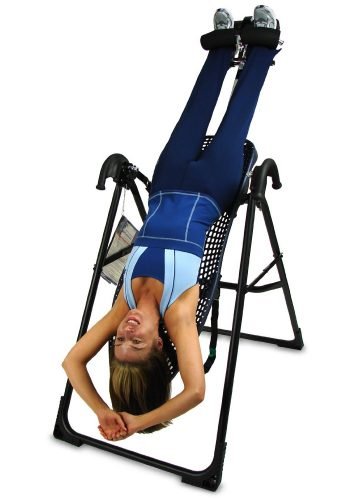There is no one definitive answer to this question, as it will vary from person to person. Your physical health, any problems that you might have with the spine, your age, level of experience with inversion tables, all this will impinge upon the degree to which you should invert. However, some general set of guidelines is commonly agreed upon in relevant circles.
As ever, beginners should keep to the minimum level before getting used to inversion, at least for a couple of weeks. In general, a 20 to 30-degree angle beyond horizontal is a good place to start until you become comfortable with the operation of the table, and being inverted.
Now that the novices are taken care of, let’s get to the meat of the matter. For a start, we’ll discuss the 20 to 30-degree angle, its good sides, and who might benefit from it, besides the beginners in their quest to get used to inversion. This is the angle where your body begins to feel mild effects of inversion, such as slight stretching. Your muscles start, well… stretching, your joints cracking, the blood flow increases, more oxygen flows to the head, and you will start feeling re-energized, overall. You may also experience some slight internal organ shift, but you’ll get accustomed to the feeling soon enough.
The next step takes you about 60 degrees beyond horizontal. This is the position where you’re parallel with the rear legs of the inversion table, and where the average user may experience the full benefits of an inversion table. The spine will receive just the right amount of traction that it requires to decompress, and elongate. This will pull your vertebrae apart, relieving the pressure on any clenched nerves, thereby relieving any pain or discomfort in your back you might experience.
Finally, we get to 90-degrees or full inversion. The astute reader will conclude that this is where you are positioned perpendicular to the floor. In other words, you’re fully upside-down. This is the position that allows your body to hang freely, enabling you to perform a variety of exercises and stretches. Of course, by now it should go without saying that you do not have to and should not go to full inversion if you do not feel comfortable with it. This angle may benefit everyone, but professional athletes are the ones that will get the most of the extra traction that full inversion provides. This is only logical, as stronger muscles and ligaments, the likes of which you’ll find on professional athletes, will need higher loads to fully decompress.
Finally, there’s one other point to discuss – intermittent traction and/or oscillation. The first implies alternating for 15 to 30 seconds inversion with returning to a normal, upright position, while the latter is simply rhythmic rocking back and forth while inverted. These are the preferred methods among the professionals, speaking of medical experts and inversion practitioners both. These methods stimulate blood flow and also enhance the removal of waste in and around injured discs. The bottom line is – whichever way you go about it, go slow, and only increase your angle and time spent as you become more and more comfortable with being inverted. As long as you don’t go overboard, you’re golden.





